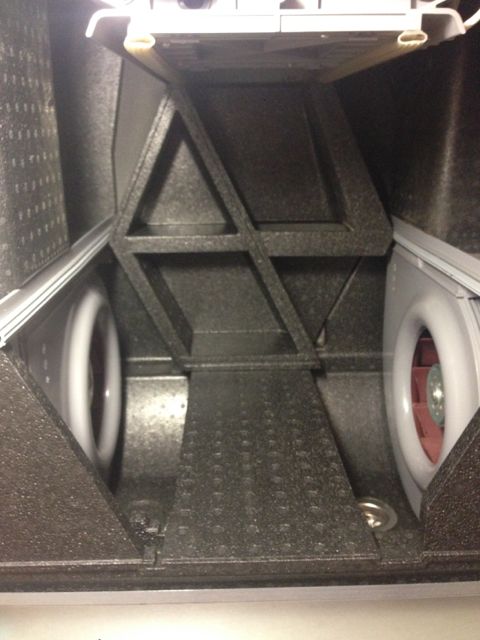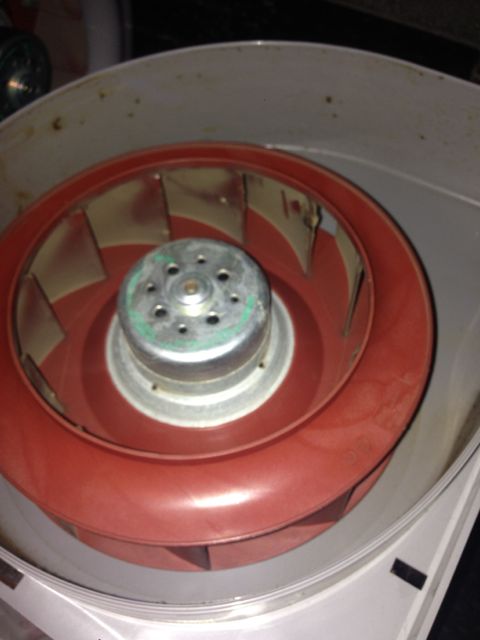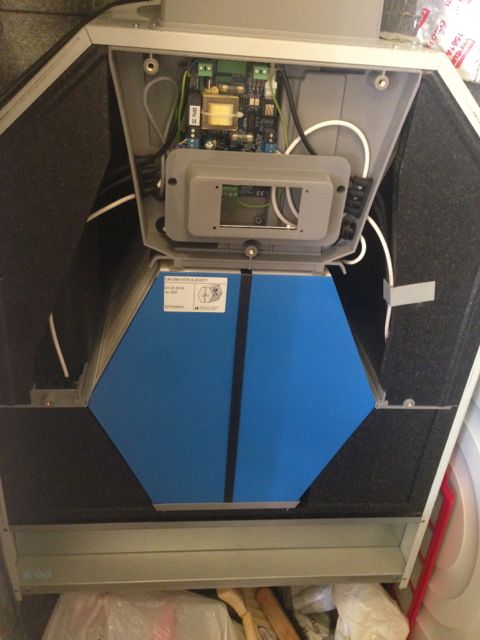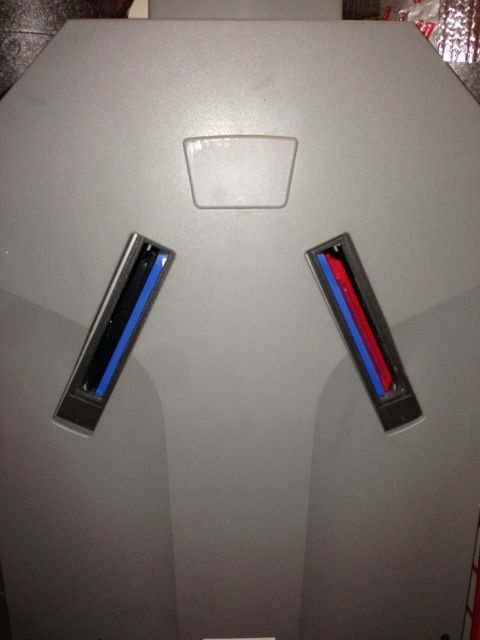Winter Experiment: Heat Recovery Ventilator (HRV) to Energy Recovery Ventilator (ERV)
On November 18, 2016 we did some maintenance. The Zehnder ComfoAir 350 ventilation system is the heart of our Passive House (Passivhaus in German). It continuously provides pre-warmed filtered fresh air to different rooms and exhausts stale air from kitchen and bathrooms. The heat recovery ventilator (HRV) was originally installed four years ago and commissioned in January 2013. In addition to cleaning out the filters couple of times a year, we were supposed to clean out the HRV core annually. This was the first time we pulled out our HRV core and it was quite dirty.

We also pulled out the bypass duct. Our system is configured as ComfoAir 350 LEFT where the fan on the right side move the air in and out of the house (through ComfoPipes) and the fan on the left move the air within the house (through ComfoDucts.) In the LEFT version the bypass duct (black hexagonal foam) is installed behind the core.

The body of the ComfoAir 350, the casing that housed the core, was dirty too. Our first task was to clean out the dust, dirt, and dead bugs. We didn't have a vacuum cleaner handy, so we simply wiped down the surface with damp paper towels.

There are two fans: one of the right and another on the left. We pulled out the fan on the right side, opened it up, cleaned it, and replaced it. Then repeated the procedure with the left. We took care to not pull on the power cables attached to the fan.

Now that everything is clean again, it's time to replace the core. Instead of re-installing the HRV core we chose to install the ERV core (enthalpy exchanger). Note that the ERV core is blue. The color of the HRV core was teal. This will help redistribute the moisture extracted from the kitchen and bathrooms to the other rooms. We are doing this because we live in a dry climate. In the winter the air outside is so dry. When the dry air is brought into the house the relative humidity in some of the rooms drop below 30 percent. So, to avoid dry skin and chapped lips, we are doing an experiment this winter.

We replaced the front covers and the filters. We use the red F7 filter (MERV 13) on the right (towards ComfoPipe) and the black G4 filter (MERV 7/8) on the left (towards ComfoDuct).

We will be collecting the temperature and humidity data through our WELserver. While our sophisticated body sensors (skin and lungs) will tell us whether our experiment was a success or not, the measurements of relative humidity will convey them in numbers. Stay tuned.
About the Author
Chie Kawahara
Chie is one of the co-creator of Midori Haus. When she is not sharing her stories of transforming an old house and giving tours, she enjoys trail running and hiking.
We also have the Zehnder ComfoAir 350 HRV and with our dry winter climate I’m interested in performing this same upgrade to ERV core. Can you tell me if there were any noticeable (or measurable) improvements in the indoor winter humidity?
Hi Eric,
Thanks for your question. I’ve noticed a “slight” improvement in that my lips are chapped less in the winter after we switched to the ERV core. I haven’t crunched the indoor humidity data to compare the numbers… yet.
I suspect that the issue is relatively high ventilation rates for the occupancy. Passive House aims for 0.3 ACH average ventilation rate, but with only two of you in a three bedroom house, that may be too high. High rates of ventilation will cause dry interior air in winter (and higher energy consumption), since the relative humidity drops as the air is warmed. Only the absolute humidity stays the same.
Also… in order to achieve Passivhaus status (.59ACH on the blower door test at 50 pascals) the design most likely employed some air resistive materials or techniques. Can you elaborate on what was done, and the materials used, to meet these design criteria?
James, I’ll see if either Graham or Kurt would comment on your question.
By the way, If you’re local (Santa Cruz or SF Bay Area), there is a PG&E class on air sealing taught by Terry Nordbye, our air sealing consultant, coming up on May 15. https://pge-web.ungerboeck.com/classcalendar/Details.aspx?OrgCode=10&EventId=17448
Any idea what is driving your relative humidity levels so low? Looking online, Santa Cruz has an average relative humidity level that is above 80% throughout the year.
Did you perhaps use a variable perm moisture barrier in the retrofit that allows moisture to pass through at lower levels but blocks moisture at higher levels? Would that barrier then act like a pump allowing flow outward during low periods but block incoming humidity during high periods?
Was there some other aspect of the retrofit design that is intended to allow the structure to dry to the outside that is playing a part?
No, we didn’t use anything to specifically block out moisture .
The readings from our temperature and relative humidity sensor show that the outside air is really quite dry in the winter, especially when it’s not raining. There’s a weather station 2 miles away from our house that provides comprehensive weather data. On this page you can see that external relative humidity had dipped below 30% number of times during the month of December 2016. http://www.weathercat.net/wxwuhistory.php?ID=KCASANTA115&month=04&day=22&year=2017&units=E&mode=3#
Despite being close to the ocean, we are in a dry climate. The low humidity bothers me only during the winter months when there is no rain. I’ve noticed my lips would chap and skin dry out during the winter even before living in a Passive House.
Thanks for asking an insightful question.
I have reviewed the information that you pointed to for weather data and see an average mean humidity of 82% for data in the months of January through March. The average low humidity is 61% for the same three months. The lowest daily mean humidity was 49% and the lowest daily low humidity for the same time period is 23%.
With the average mean of 82% and lowest mean of 61%, I wouldn’t consider the area as dry. Might it be possible that the ventilation unit is operating during the low humidity periods and a possible solution is to change the scheduling to coincide with a desired humidity level?
I have found the information at https://nsrdb.nrel.gov helpful for analyzing historical weather data in 30 minute snapshots.
We run our HRV/ERV 24×7. The only time we unplug it is when we choose not to bring in outside air when it’s smoky (neighbors burning wood in fire pits or fire places). We do have charcoal filter (ComfoWell) in the HRV air intake in addition to the red filter (MERV 13) in the body of ComfoAir 350. I think this may be making our indoor air a touch drier than the outside.
Right now the outdoor temperature (shaded area of my deck) is 72F and the R/H is 44%. Inside the house the temperature is 71F and R/H is 40% in the kitchen and one of the bathrooms. In the bedroom it’s 73F and 30%. I use the data from Weathercat.net as a reference point for outdoor temperature because that private weather station is located just 2 miles away from our house and reflects our micro climate. Their data shows 67F and 71% R/H. Our R/H reading is lower than Weathercat.net. Difference in location, sensor equipment? I’m not sure what it is.
In any case, I plan to compare our indoor R/H data from this year to last year to see if and how much ERV contributed to our indoor R/H.